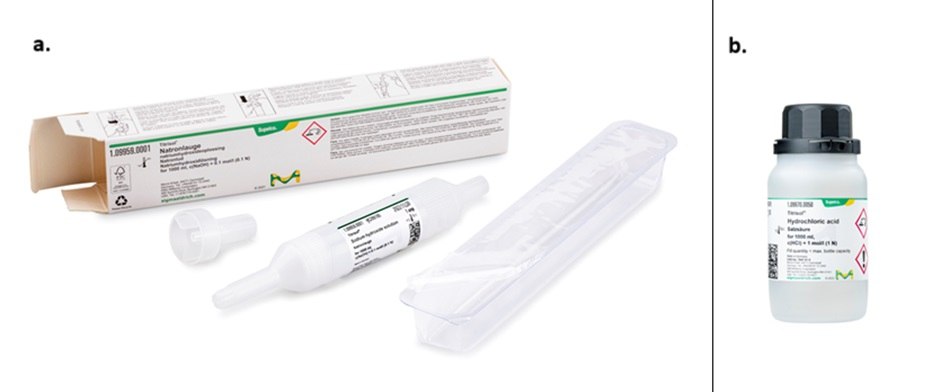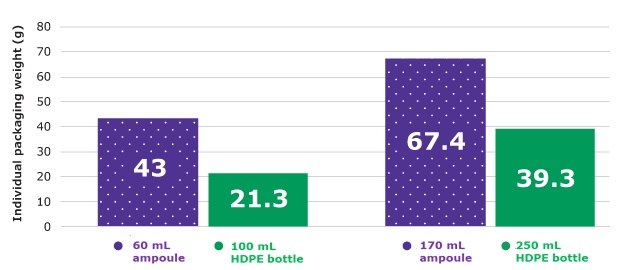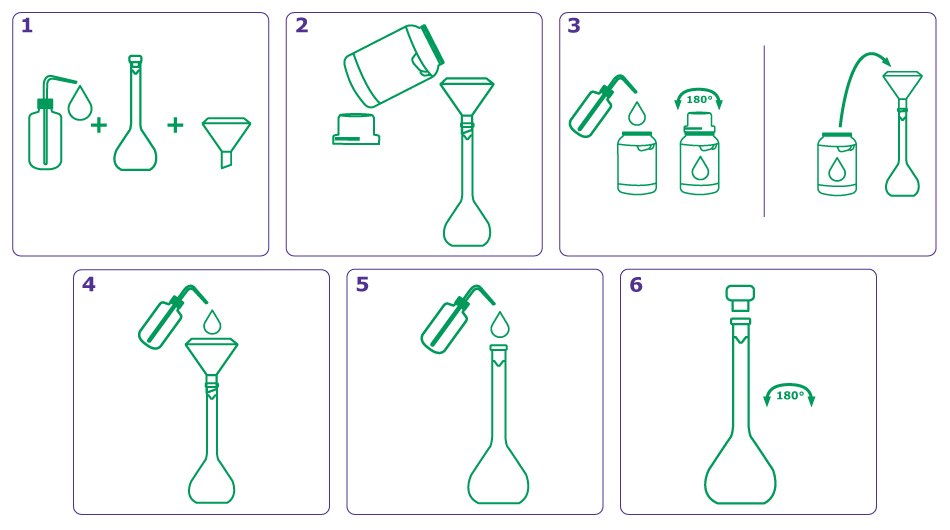Titrisol® Concentrates
Introduction
For decades, Titrisol® concentrates have been commonly used in analytical laboratories for the preparation of volumetric solutions, calibration standards, and buffer calibration solutions. These concentrates provide flexibility in solution preparation by dilution to achieve individual concentrations, as required by the analytical method or application.
In a significant step towards enhanced sustainability and user convenience, Titrisol® concentrates have shifted from conventional polyethylene (PE) ampoule packaging to small HDPE (high-density polyethylene) bottles. This packaging change leads to a measurable reduction in non-recyclable and multi-component materials. It also minimizes the use of materials such as polyethylene (PE) funnels, polyvinyl chloride (PVC) blister packs, and outer cartons. The new HDPE bottle packaging reduces environmental impact and enhances handling efficiency in laboratory workflows.

Figure 1.(a) Ampoule packaging (PE ampoule, PE funnel, carton, PVC blister pack),
(b) HDPE bottle packaging
The transition from ampoule-based packaging to small HDPE bottles results in the elimination of several packaging components, including cartons, polyethylene (PE) funnels, and polyvinyl chloride (PVC) blister packs. PVC is classified as a material of environmental concern due to its limited recyclability and associated disposal challenges. This change is projected to reduce packaging waste by approximately 2.6 metric tons annually, corresponding to an estimated reduction of 7.5 metric tons of CO₂ equivalent emissions.

Figure 2.Titrisol® concentrates packaging weight reduction.
Titrisol® Product Line
Titrisol® concentrates are available to prepare volumetric solutions for titration, calibration standards for trace analysis, and buffer solutions for calibration of pH instruments.
Titrisol® Volumetric Solution Concentrates
These concentrates are used in titration to prepare a volumetric solution for determining the quantitative amount of a specific analyte.
Titrisol® volumetric solution concentrates in HDPE bottles:
- Sodium hydroxide (0.1 mol/L), 100 mL
- Sodium hydroxide (1 mol/L), 250 mL
- Hydrochloric acid (0.1 mol/L), 100 mL
- Hydrochloric acid (1 mol/L), 250 mL
- Sodium thiosulfate (0.1 mol/L), 100 mL
- Sulfuric acid (0.05 mol/L), 100 mL
Titrsiol® AAS Standard Concentrates
These concentrates are used to prepare calibration standards required for atomic absorption spectroscopic analysis.
Titrisol® AAS calibration standard concentrates in HDPE bottles:
- Iron standard, 1000 mg Fe (FeCl3 in 15% HCl), 100 mL
- Copper Standard, 1000 mg Cu (CuCl2 in H2O), 100 mL
Titrisol® Buffer Calibration Solution Concentrates
These concentrates are used to prepare a buffer solution to calibrate pH instruments.
Titrisol® buffer calibration solution concentrates in HDPE bottles:
- Buffer calibration solution pH 7.00, 100 mL
- Buffer calibration solution pH 4.00, 100 mL
- Buffer calibration solution pH 3.00, 100 mL
- Buffer calibration solution pH 9.00, 100 mL
Features and benefits of the Titrisol® HDPE bottles
- Contributes to more sustainability: By reducing the use of PE, PVC, and carton packaging materials.
- Convenient and easy to use: The new bottles are designed for easy and hassle-free handling during solution preparation. The required volume can be directly dispensed into the volumetric flask using a funnel, streamlining the process and saving time
- Flexibility in concentration: The concentrates in bottles allow for flexible dilution, enabling users to prepare solutions at concentrations tailored to specific analytical requirements
- Cost Saving: The packaging reduces the volume and type of packaging materials used, which contributes to lower waste disposal and transportation costs, supporting cost-efficient laboratory operations
Preparation of Solutions Using Titrisol® Concentrates

Figure 3.Preparation of solutions using Titrisol® concentrates (See steps below).
- Step 1: Use a measuring flask, a glass funnel, and a wash bottle filled with distilled water.
- Step 2: Open the Titrisol® HDPE bottle and use a glass funnel to transfer its content into the measuring flask.
- Step 3: Fill the empty Titrisol® bottle with distilled water, close the lid, and turn it over 180° to mix. Reopen the bottle and transfer the rinse into the volumetric flask. Repeat this rinsing step 2-3 times to ensure complete transfer.
- Step 4: Rinse the glass funnel by pouring distilled water along its walls into the measuring flask.
- Step 5: Remove the glass funnel and fill the measuring flask with distilled water up to the mark at 20 °C.
- Step 6: Cap the volumetric flask and invert it a few times (180°) to homogenize the solution.
Note: We recommend performing a titer determination before proceeding with sample analysis
AAS Calibration Standard Concentrates
Buffer Calibration Solution Concentrates
To continue reading please sign in or create an account.
Don't Have An Account?